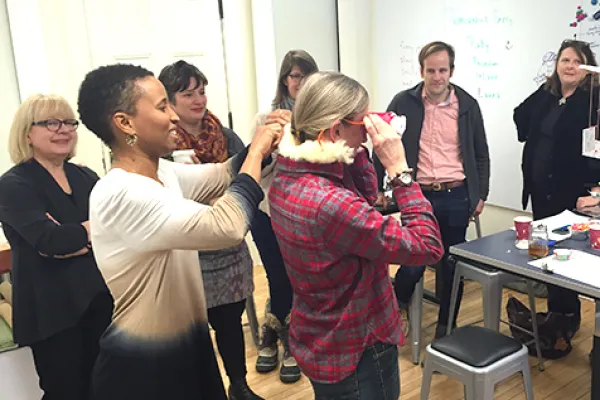Creative Space: Design Thinking Initiative Hosts Capen Annex Open House
Campus Life

Published March 3, 2016
“What’s inside?”
That’s the question behind the grand opening of the Design Thinking Initiative’s new space in Capen Annex Tuesday, March 8, from 11:30 a.m. to 1:30 p.m. The event includes lunch, music and some hands-on design, using a combination of traditional and state-of-the-art equipment.
The initiative’s newly renovated space consists of a flexible, studio-style classroom on the first floor that is tailored to collaborative projects. The second floor features a prototyping studio stocked with tools for bringing ideas from the design phase to reality—including a 3D printer. The studio is open to all members of the Smith community. (To register to use the space, contact the design thinking team at capen@smithiesdesign.com.)
The college’s Design Thinking Initiative is a four-year pilot program aimed at incorporating problem framing and other design thinking concepts into the curriculum and student- and faculty-led projects.
At the grand opening March 8, Smith community members will have a chance to see how Capen Annex is being used for classes, workshops, meetings and all-college design challenges.
Capen Annex is a place where thinking and making go hand in hand.
The first such challenge is set for Saturday, April 2, from 10 a.m. to 4 p.m. at Capen Annex. Participants are invited to spend a day exploring the concept of “belonging” at Smith and to work in teams designing promising ideas for supporting diversity and inclusion on campus. (For information on the challenge, contact Zaza Kabayadondo, co-director of the Design Thinking Initiative, at zkabayadondo@smith.edu.)
Borjana Mikic, faculty director of the Design Thinking Initiative, says the program’s new headquarters aims to be a hub for creative learning at Smith.
“Capen Annex is a place where thinking and making go hand in hand,” Mikic says. “In keeping with our design thinking principles, the space will always be a work in progress, adapting and evolving over time to meet the changing needs of those who use it.”
Renovations that began last fall involved knocking down walls in Capen Annex and installing adaptable furniture and equipment designed for group projects.
It promises to be an engaging space for interdisciplinary exploration and learning for students and faculty alike.
Zaza Kabayadondo, co-director of the Design Thinking Initiative, says students in her design thinking courses have responded enthusiastically to the new space.
“They tell me that when they come here for class, they know they can lower their guard and be themselves,” Kabayadondo says.
Susan Etheredge, professor and chair of education and child study, says she is excited about the possibility of teaching in Capen Annex. “It promises to be an engaging space for interdisciplinary exploration and learning for students and faculty alike,” she says.
So, what’s inside?
Here are some things to look for at the March 8 grand opening:
- High-tech equipment: A vinyl cutter, laser cutter, 3D printer and 3D pens are just some of the new design tools housed in Capen Annex. Each tool empowers learners in the space to put questions or ideas they are formulating into tangible form.
- Low-tech equipment: The classroom and prototyping studio are equipped with carts full of craft and hand tools, toys, textiles and repurposed materials for groups and individuals to use as design concepts evolve. “Reset” instructions help remind users about how to leave the flexible studio intact for the next group of design thinkers.
- Smithie-built furniture: The classroom has worktables and a whiteboard that design thinking students built from a collection of flexible classroom furniture. Claire Adams ’16 was one of them. “I’m excited to introduce the space to the campus and have more people work on projects there,” she says. “It’s important for the campus community to know that design thinking is available to people from all different disciplines.”
- Traces of Smith history: Wooden latticework and other remnants of the old Capen Annex are displayed in the stairwell as a way of preserving the building’s history. For more on that topic, don’t forget to ask about the secret passageway to the basement!
Digital scholarship librarian Miriam Neptune (front left) helps government professor Mlada Bukovansky put on goggles during a faculty workshop in the Design Thinking Initiative's new space in Capen Annex.